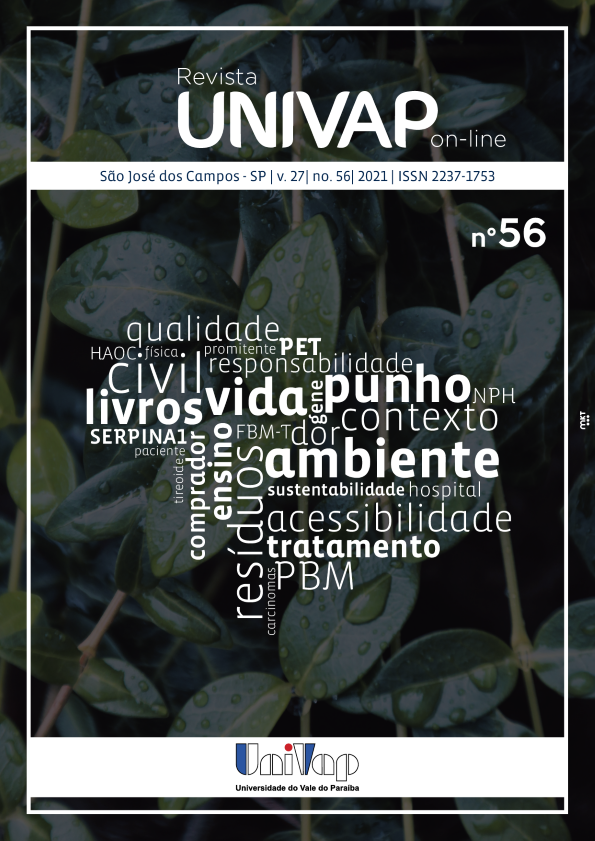DEVELOPMENT OF A SMARTPHONE DEVICE FOR READING AIMED AT LOW-VISION PEOPLE
DOI:
https://doi.org/10.18066/revistaunivap.v27i56.2341Palavras-chave:
Visual impairment, low vision, rehabilitation, assistive technology, software.Resumo
Many people with total or partial visual impairment can use assistive technology (AT) to facilitate daily living activities. Smartphones and, especially, their applications, can be a tool of easy access and applicability as AT. The aim of this study was to develop an application for use on a smartphone or tablet to improve the visual ability of people with low visual acuity. The software, called Oftcam, was developed using the ANDROID operating system, written in Java Android under the Java version JDK 1.7, supporting the minimum version of Android 2.2. Its operating mechanism includes capturing and adjusting the image of interest to the users according to their needs: expansion, change of background and decentralization of the image of interest. The development of this free, easy-to-handle application will provide the possibility of integration between the user and the auxiliary professional, being, in practice, a mobile resource of health. Considering that most people have an increasing access to phones and tablets, we believe the use of this application is a good alternative to integrate the need and practicality in the daily lives of the visually impaired people.
Downloads
Referências
ALVES, C. C. Et al. Assistive technology applied to education of students with visual impairment. Rev. Panam. Salud Publica, v. 26, n. 2, p. 148-152, 2009.
BITTNER, A. K., et al. Feasibility of Telerehabilitation for Low Vision: Satisfaction Ratings by Providers and Patients. Optom. Vis. Sci., v. 95, n. 9, p. 865-872, 2018.
CHENG, N.; CHAKRABARTI, R.; KAM, J. Iphone applications for eye care professionals: A review of current capabilities and concerns. Telemedicine and e- health., v. 20, n. 4, p. 385-7, 2014.
COLENBRANDER, A.; FLETCHER, D. Low vision rehabilitation. A study guide and outline for ophthalmologists, residents and allied health personnel Anaheim. Joint Commission on Allied Health Personnel in Ophthalmology, p. 1-14, 2003. Available from: https://pdfs.semanticscholar.org/a774/73a1ae99b2b8f9d10eddb0edb5fc169119b1.pdf. Acess in: 10 jan. 2016.
COWAN, R. E. et al. Recent trends in assistive technology for mobility. Journal of NeuroEngineering and Rehabilitation, v. 9, n. 20, p. 1-8, 2012.
CYPEL, M. C. et al. Vision status, ophthalmic assessment, and quality of life in the very old. Arq Bras Oftalmol., v. 80, n. 3, p. 159-64, 2017.
DELOGU, F. et al. Non-visual exploration of geographic maps: Does sonification help? Disability and Rehabilitation. Assistive Technology, v. 2010; v. 5, n. 3, p. 164-174, 2010.
DU TOIT, R. A Global Public Health Perspective: Facilitating Access to Assistive Technology. Optom. Vis. Sci., v. 95, n. 9, p. 883-888, 2018.
HAKOBYAN, L. et al. Mobile Assistive Technologies for the visually impaired. Survey of Ophthamlology, v. 58, n. 6, 513-518, 2013.
IBGE. Instituto Brasileiro de Geografia e Estatística. Census 2010. Available from: http://www.ibge.gov.br/home/. Acess in: 10 jan. 2016.
MEYER, C. H. et al. Healthcare "Apps" for Smartphones: Relief or toy for patients and the visual impaired? Ophthalmologe, v. 109, n. 1, p. 21-29, 2012.
ONG, S. K.; ZHANG, J.; NEE, A. Y. C. Assistive obstacle detection and navigation devices for vision-impaired users. Disability and Rehabilitation: Assistive Technology, v. 8, n. 5, p. 409-416, 2013.
PIZZARELLO, L. et al. Vision 2020: The Right to Sight: a global initiative to eliminate avoidable blindness. Arch Ophthalmol., v. 122, n. 4, p. 615-620, 2004.
STANZEL, B. V.; MEYER, C. H. Smartphones in der Augenheilkunde Ophthalmologe. Der Ophthalmologe, v. 109: 8-20. 2012.
STEVENS, G. A. et al. Global prevalence of vision impairment and blindness: magnitude and temporal trends, 1990-2010. Ophthalmology., v. 120, n. 12, p. 2377-2384, 2013.
STUMP, M. Low vision assistance with mobile devices. New York. 103 p. Degree of Master of Science in Computer Engineering. Department of Computer Engineering. Rochester Institute of Technology. 2011.
THOMAS, R. et al. Assistive technology for children and young people with low vision. Cochranes, v. 10 (CD011350), p. 1-28, 2014.
TRAUZETTEL-KLOSINSKI, S. Current Methods of Visual Rehabilitation. Deutsches Ärzteblatt International., v. 108, n. 51-52, p. 871-878, 2011.
WHO, World Health Organization. Deficiência visual. Available from: http://www.deficientesemacao.com/deficiencia-visual. Acess in: 10 jan. 2016.
WITTICH, W.; SOUTHALL, K.; JOHNSON, A. Usability of assistive listening devices by older adults with low vision. Disability and Rehabilitation. Assistive Technology, v. 11, n. 07, p. 564-571, 2015.
Downloads
Publicado
Como Citar
Edição
Seção
Licença

Esse trabalho está licenciado com uma Licença Creative Commons Atribuição 4.0 Internacional.
Esta licença permite que outros distribuam, remixem, adaptem e criem a partir do seu trabalho, mesmo para fins comerciais, desde que lhe atribuam o devido crédito pela criação original.
http://creativecommons.org/licenses/by/4.0/legalcode


